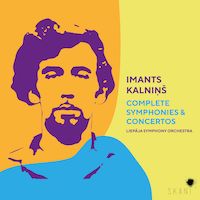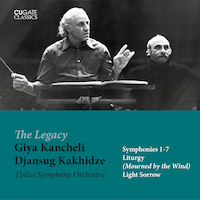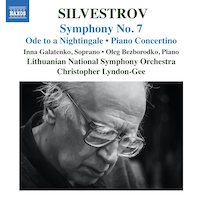Mostly Symphonies 38: Kalniņš, Kancheli and Silvestrov
|
Grant Chu Covell [May 2021.]
“Imants Kalniņš: Complete Symphonies and Concertos.” Imants KALNIŅŠ: Symphony No. 1 (1964)1; Symphony No. 2 (1965)2; Symphony No. 3 (1968)3; Symphony No. 4 (1973)4; Symphony No. 5 (1979)5; Symphony No. 6 (2001)6; Symphony No. 7 (2015)7; Concerto for Cello and Orchestra (1963)8; Concerto for Orchestra (1966)9; Concerto for Oboe and Orchestra (2012)10; Finale from Pūt, vējiņi (1973)11; Santa Cruz (2015)12. Pēteris Endzelis10 (ob), Māris Kupčs11 (e-guit), Aivars Meijers4 (b-guit), Vilnis Krieviņš4 (drums), Marta Sudraba8 (vlc), State Choir “Latvija,”6 Atvars Lakstīgala1,2,3,4,5,8,9,11, Māris Sirmais6,7,10,12 (conds.), Liepāja Symphony Orchestra. SKANI LMIC 087 (5 CDs) (www.lmic.lv). Kalniņš (b. 1941) skillfully blends rock and classical, resulting in an approachable oeuvre of symphonies and concertos. Kalniņš’ trajectory demonstrates an adept assimilation of mid-century Soviet trends, as well as a profound understanding how a well-crafted song can supersede the need for parody. Wikipedia summarizes: “…[Kalniņš] is generally best known for his rock songs and is to be considered the first composer of intellectual rock music in Latvia.” These recordings were made between 2014 and 2020 and should be considered definitive. No. 1 reflects Soviet aesthetics. Most every symphony from Russia, or any of the Baltic states asks for a comparison with Shostakovich or Prokofiev. Kalniņš offers required doses of monumentalism, an ironic polka, emphatic xylophone, and deliverance in the guise of a solo flute. No. 2 continues to demonstrate Kalniņš’ adept scoring, but also demonstrates a hallmark of the Latvian’s style: Movements are built from dissimilar sections containing tunes harmonized or colorfully scored. No. 3 was sparked by Kalniņš’ friend Pärt who suggested he write the most daring music possible. The five movements pass quickly, and what might seem like grotesque circus music becomes surrounded or diminished by contrasting material. No. 4 might be Kalniņš’ best known symphony. Kalniņš reuses a song (“Seven Sorrowful Stars”) which builds impressively in the first movement. With guitar and drumkit, imagine the orchestra as a conveyor belt obdurately presenting a series of variations. The remaining movements cover the gamut from the serious to the absurd, deftly alternating rock opera with pathos. A straightforward line develops inexorably in No. 5, which might reflect Sibelius’ approach to unfolding melodies. Closing mysteriously, the Fifth is smartly orchestrated with clever recourse to percussion. In the third movement, Allegro festivo, mocking ideas appear alongside gentler themes, reflecting Kalniņš’ continuing skillful dispersion of irony. No. 6 constructs long melodic stretches over propulsive rhythms. Not just because a chorus appears, Kalniņš’ grammar seems simpler, as if all music could be reduced to cautionary anthems. Similarly, No. 7 becomes more lyric, less aggressive, even heroic, and could be mistaken for John Williams. The Cello Concerto is Kalniņš’ first symphonic work. Commencing with a brooding cello melody, the orchestra introduces other ideas as if all the preceding were in error. The notes suggest this single movement reflects Latvian persistence under Soviet domination. There are clear sections, a strong climax and a lyrical conclusion. The 18-minute single-movement Concerto for Orchestra wanders. Perhaps this is an early example of Kalniņš’ building large structures by accumulating contrasting, unrelated sections. A lengthy percussion passage tests endurance rather than creating tension. The Oboe Concerto is tuneful and elegant, but admittedly was written decades later and represents a composer in confident control of form and orchestration. Similarly, the five-minute Santa Cruz is a sweet music box, a delicate tonal waltz. The Finale to the movie Pūt, vējiņi (“Blow, Wind”) is somber and grand, even with its electric guitar solo. The film has a following in its homeland.
Giya KANCHELI: Symphony No. 1 (1967); Symphony No. 2, “Chants” (1970); Symphony No. 3 (1973); Symphony No. 4 (1974); Symphony No. 5 (1977); Symphony No. 6 (1980); Symphony No. 7, “Epilogue” (1986); Light Sorrow (1985); Mourned by the Wind (1986). Tblisi Symphony Orchestra, Djansug Kakhidze (cond.). Cugate Classics CGC 050 (5 CDs) (www.cugate-classics.com). Kancheli (1935-2019) was inspired to study music instead of geology upon hearing Stravinsky’s Rite of Spring. The two-part No. 1 obscures the Georgian composer who would become a master of the deliberately slow and melancholic. The first movement is aggressively paced, the second is leisurely but with complex flareups. The subsequent symphonies will offer less material and be more impressive, although the shattering outbursts persist. The First’s premiere was conducted by Kakhidze, and for every subsequent orchestral work, Kancheli had his friend Kakhidze in mind as chief interpreter. This collection reissues recordings made in 1994 and ’95. No. 2’s subtitle, “Chants,” indicates Kancheli’s direction. Songs and lyric lines become his universe’s focus. We also hear abrupt shifts between calm and virulence, and a near obsessive handling of small motifs. The same could be said about the Third, which adds a lone voice (uncredited in this reissue) as the orchestral surges yield towards a melodic and sorrowful place. Dedicated to the memory of Michelangelo, the Fourth opens with chimes. The alternation of gigantic gestures, forlorn harmonies and a grotesque waltz is not unlike Ives, although Kancheli paints an especially bleak picture. In No. 5, an antique harpsichord tune is chided by the massed orchestra, setting up a conflict between innocence and an unsmiling reality. Is the symphony really this simple? The Sixth awakens gradually, deceptively subdued and tender. However, the meager tonal gestures, broad silences and eventual jabbing tuttis suggest immense pain. Sporadic momentum contrasts quieter moments against aggressive full orchestra. Sure, it’s possible to hear a bit of Mahler here and there, but Kancheli treads a fine line writing a symphony which skillfully alternates emptiness and anger. In No. 7 fanfares compete with glacial chords and lyric moments become smothered in dissonant, twinkling harmonies. An electric guitar anchors the harmonies. No. 7 can be aligned with the obtuse juxtapositions of Nos. 4 and 5, which makes the intervening Sixth appear darker. There are bits which suggest Schnittke’s Eighth and most anything by Silvestrov. Commissioned for the 40th anniversary of the defeat of fascism, Light Sorrow is dedicated to all children and young victims of WWII. With soloists and choir (uncredited), Light Sorrow includes Kancheli’s signature contrasts, exemplified by a pair of boy sopranos and a menacing orchestra. Texts are by Shakespeare, Goethe, Tabidze and Pushkin. Mourned by the Wind: Liturgy in Memory of Givi Ordzhonikidze is for orchestra with solo viola (uncredited, but apparently Yuri Bashmet). The orchestra also includes spinet and electric guitar. Ordzhonikidze was a musicologist and close friend to Kancheli. Beethoven’s Ninth is quoted in second movement. Lengthened modal cadences become monuments. Some listeners will find this the most sentimental and maudlin music ever. But that will be precisely why others may love it. These performances are as official as they come, and the recordings capture the extremes in volume without becoming soupy. Kancheli has been a mainstay at ECM for several years. His brand of slow sentimentality fits right in, but I have found the ECM releases cloying and unbearable (particularly Chiaroscuro and Lament, even though the last is dedicated to Nono). These Cugate recordings are far more chiseled, even aggressive, yet the melancholy filters through.
Valentin SILVESTROV: Ode to a Nightingale (1983)1; Cantata No. 4 (2014)2; Concertino for Piano and Small Orchestra (2015)3; Moments of Poetry and Music (2003)4; Symphony No. 7 (2003)5. Inna Galatenko1,2,4 (sop), Oleg Bezborodko1,2,3,4 (pno), Lithuanian National Symphony Orchestra1,2,3,4,5, Christopher Lyndon-Gee1,2,3,4,5 (cond.). Naxos 8.574123 (1 CD) (www.naxos.com). The Keats setting translated into Russian is unmistakably Silvestrov despite the flirtatious birdsong from piano. At nearly 20 minutes, the Ode grows weighty and foreboding, tonal chords slowly churning under the bubbly soprano line. The Cantata’s texts are by Simeon Ivanovich Antonov (“Silouan’s Song”), Taras Shevchenko (“Evening”) and Pavlo Tychyna (“My Soul Swathed in Celestial Azure”). The second movement, Pastorale, is purely instrumental and reappears in the Piano Concertino. The songs offer the meandering tonal sweetness we have come to expect from Silvestrov, that unsettling Mozart and Mahler potpourri. Moments is in two parts: the first uses a poem by Celan (in Russian), the second is for strings. The Celan fragment for voice and piano flirts with a tone row. In contrast, the string orchestra movement is a drifting bittersweet Romantic trifle. Pianist Bezborodko appears in most of these pieces, except for the Symphony (which actually has a piano solo in it, but played by Marija Grikevičiūtė), so his stepping forth in the Concertino is like throwing open a curtain to catch the last rays of twilight. At 19 minutes and in four movements, the Concertino is modest, perhaps sheepish, the orchestra accompanying the piano almost reluctantly. It’s as if we’re hearing music evaporate. The Serenade movement offers a tune which sounds familiar, it could be Scottish or Sicilian, or something by Morricone or Rota. The big draw is the Seventh in its first recording. However, the Ode and the Concertino are longer pieces as the Seventh weighs in at just over 17 minutes (though the piece ends quietly and probably finishes before the 17-minute mark). The Seventh presents the minor-mode nostalgic language we’ve heard before in Nos. 5 (1980-82) and 6 (1994-95). Bass instruments provide rumbling weight under cascading string and wind phrases recollecting Mahler. However, the rocking harmonies go nowhere, melodies incorporate dissonant “wrong notes,” and the sun sets over and over again. Unfamiliar listeners may be taken in by its gentleness and familiar suggestions even though the dark areas are very dark. I am unsure what Silvestrov is trying to say, and unclear where he means to take us.
[More Grant Chu Covell, Mostly Symphonies]
[Previous Article:
Used Bin Troll Tweets YY.]
[Next Article:
String Theory 36: Predominantly Quartets]
|


